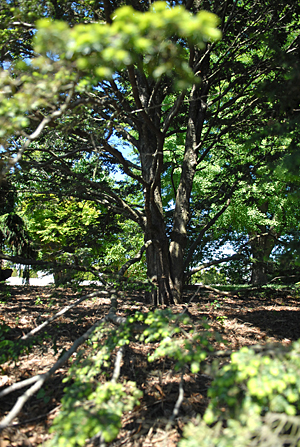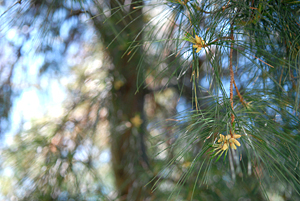
ADVERTISEMENT
- Rozovsky wins prestigious NSF Early Career Award
- UD students meet alumni, experience 'closing bell' at NYSE
- Newark Police seek assistance in identifying suspects in robbery
- Rivlin says bipartisan budget action, stronger budget rules key to reversing debt
- Stink bugs shouldn't pose problem until late summer
- Gao to honor Placido Domingo in Washington performance
- Adopt-A-Highway project keeps Lewes road clean
- WVUD's Radiothon fundraiser runs April 1-10
- W.D. Snodgrass Symposium to honor Pulitzer winner
- New guide helps cancer patients manage symptoms
- UD in the News, March 25, 2011
- For the Record, March 25, 2011
- Public opinion expert discusses world views of U.S. in Global Agenda series
- Congressional delegation, dean laud Center for Community Research and Service program
- Center for Political Communication sets symposium on politics, entertainment
- Students work to raise funds, awareness of domestic violence
- Equestrian team wins regional championship in Western riding
- Markell, Harker stress importance of agriculture to Delaware's economy
- Carol A. Ammon MBA Case Competition winners announced
- Prof presents blood-clotting studies at Gordon Research Conference
- Sexual Assault Awareness Month events, programs announced
- Stay connected with Sea Grant, CEOE e-newsletter
- A message to UD regarding the tragedy in Japan
- More News >>
- March 31-May 14: REP stages Neil Simon's 'The Good Doctor'
- April 2: Newark plans annual 'wine and dine'
- April 5: Expert perspective on U.S. health care
- April 5: Comedian Ace Guillen to visit Scrounge
- April 6, May 4: School of Nursing sponsors research lecture series
- April 6-May 4: Confucius Institute presents Chinese Film Series on Wednesdays
- April 6: IPCC's Pachauri to discuss sustainable development in DENIN Dialogue Series
- April 7: 'WVUDstock' radiothon concert announced
- April 8: English Language Institute presents 'Arts in Translation'
- April 9: Green and Healthy Living Expo planned at The Bob
- April 9: Center for Political Communication to host Onion editor
- April 10: Alumni Easter Egg-stravaganza planned
- April 11: CDS session to focus on visual assistive technologies
- April 12: T.J. Stiles to speak at UDLA annual dinner
- April 15, 16: Annual UD push lawnmower tune-up scheduled
- April 15, 16: Master Players series presents iMusic 4, China Magpie
- April 15, 16: Delaware Symphony, UD chorus to perform Mahler work
- April 18: Former NFL Coach Bill Cowher featured in UD Speaks
- April 21-24: Sesame Street Live brings Elmo and friends to The Bob
- April 30: Save the date for Ag Day 2011 at UD
- April 30: Symposium to consider 'Frontiers at the Chemistry-Biology Interface'
- April 30-May 1: Relay for Life set at Delaware Field House
- May 4: Delaware Membrane Protein Symposium announced
- May 5: Northwestern University's Leon Keer to deliver Kerr lecture
- May 7: Women's volleyball team to host second annual Spring Fling
- Through May 3: SPPA announces speakers for 10th annual lecture series
- Through May 4: Global Agenda sees U.S. through others' eyes; World Bank president to speak
- Through May 4: 'Research on Race, Ethnicity, Culture' topic of series
- Through May 9: Black American Studies announces lecture series
- Through May 11: 'Challenges in Jewish Culture' lecture series announced
- Through May 11: Area Studies research featured in speaker series
- Through June 5: 'Andy Warhol: Behind the Camera' on view in Old College Gallery
- Through July 15: 'Bodyscapes' on view at Mechanical Hall Gallery
- More What's Happening >>
- UD calendar >>
- Middle States evaluation team on campus April 5
- Phipps named HR Liaison of the Quarter
- Senior wins iPad for participating in assessment study
- April 19: Procurement Services schedules information sessions
- UD Bookstore announces spring break hours
- HealthyU Wellness Program encourages employees to 'Step into Spring'
- April 8-29: Faculty roundtable series considers student engagement
- GRE is changing; learn more at April 15 info session
- April 30: UD Evening with Blue Rocks set for employees
- Morris Library to be open 24/7 during final exams
- More Campus FYI >>
9:45 a.m., May 10, 2010----Gardeners delight in the first blooms of a flowering shrub, the vibrant color of a summer wildflower, a deciduous tree aflame with fall foliage. But no one stops to admire the conifer, which is often reduced to hiding home foundations or grown as a solitary sentry in the middle of an expanse of lawn.
Well, a few people do stop to admire conifers, such as Richard Bitner, a Longwood Gardens teacher, board-certified anesthesiologist, and author of Conifers for Gardens: An Illustrated Encyclopedia.
Bitner will speak about conifers at a UD Botanic Gardens lecture at 7 p.m., Tuesday, May 11, in the University of Delaware's Townsend Hall on South College Avenue in Newark. Cost is $10. To register or for more information, send email to [susanell@udel.edu] or call (302) 831-0153.
Bitner will focus on the great diversity of shapes, textures and color in this plant group and how to integrate conifers into a landscape with other woody and herbaceous plants.
Conifers are cone-bearing trees (and a few shrubs) that include such species as pines, firs, junipers, cedars, redwoods, yews and spruces. Conifers grow naturally almost everywhere in the world, including this region, which has 12 native species.
“Since they are green in the winter, conifers are often used as screens and windbreaks but they offer much on their own,” says John Frett, director of the UD Botanic Gardens. “You'll find distinct textures in the conifers as well as varied plant form, including rounded, weeping, conical and fastigiated [narrowing toward the top].”
Like Frett and Bitner, Sue Barton is a fan of conifers. “Most home gardeners aren't too enthused by conifers,” says Barton, the ornamental horticulture specialist for UD Cooperative Extension. “They want plants that stay green all year and flower all summer -- and such a plant, of course, doesn't exist.”
So gardeners turn to what they view as the next best thing -- broadleaf evergreens, which unlike conifers, often have a spring or summer bloom period. Although Barton likes broadleaf evergreens and uses them widely, she says they can't deliver the textural impact that conifers do.
Conifers also offer a wide range of colors, notes Barton. She uses unusually colored or variegated conifers as accent or specimen plants in her garden.
“The native Eastern red cedar has several cultivars. The most popular, Emerald Sentinel, has a blue-green color that turns purplish in the winter,” says Barton. “There are lots of blue conifers but none are native to Delaware except Emerald Sentinel.”
White pine has a silverly stripe on the needles that can give the tree an attractive grayish cast, says Barton. Although the white pine isn't native to Delaware it is native to the East Coast. “There also are pines with yellow bands on their needles that make an interesting effect in the garden,” says Barton.
The region's native conifers include seven pines, two cedars, a hemlock, a juniper and one deciduous conifer, a bald cypress. The pines include shortleaf, pitch, pond, table mountain, Virginia and loblolly. Delaware's native cedars are Atlantic white cedar and Eastern red cedar.
“I have Eastern red cedar planted in my home meadow,” says Barton. “In winter, I love the look of the dark green needles next to brown winter grass. It looks even better planted near winterberry holly, which has bright red berries in winter. UD landscape engineer Tom Taylor has used the combination of Eastern red cedar and winterberry in a number of places on UD's Newark campus.”
UD's Botanic Gardens also has its share of Eastern red cedars and other conifers. The Clark Garden, directly in front of Townsend Hall, features an area of dwarf conifers.
Another good place to check out conifers is Winterthur's Pinetum, which was started by Henry Algernon du Pont in 1914. This diverse collection of conifers includes pines, firs, spruces, cedars, and their relatives.
Downstate, look for mature and old-growth loblolly pine in the Inland Bays region and around the Nanticoke River, at such sites as Barnes Woods and Assawoman State Wildlife Area. In Kent County, you can find mature loblollies at the Milford Neck Conservation Area.
If you plan to add conifers to your yard, choose your site carefully. Most do best with full sun and well-drained soil. And be sure to get them into the ground at the right time.
“For most plants, spring or fall work equally well for planting. But it's best to avoid planting evergreens in the fall,” says Barton. “So plant now.”
Article by Margo McDonough
Photos by Danielle Quigley



